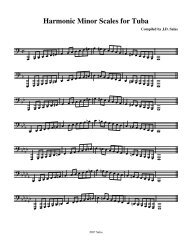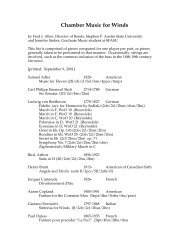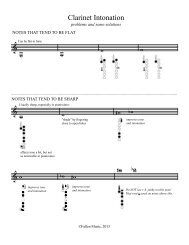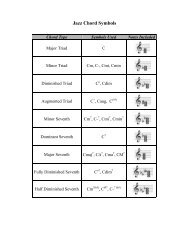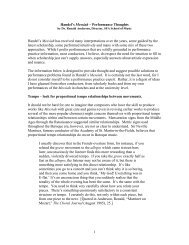Trombone Rep - History of the Trombone - Timeline 1 (EatonMensch ...
Trombone Rep - History of the Trombone - Timeline 1 (EatonMensch ...
Trombone Rep - History of the Trombone - Timeline 1 (EatonMensch ...
Create successful ePaper yourself
Turn your PDF publications into a flip-book with our unique Google optimized e-Paper software.
<strong>History</strong> <strong>of</strong> <strong>the</strong> <strong>Trombone</strong><br />
P. 21<br />
Date Information Citation<br />
1809 A.D.<br />
1811 A.D.<br />
1811 A.D.<br />
1811 A.D.<br />
Beethoven only uses two trombones sparsely in two movements <strong>of</strong> his Sixth Symphony. The<br />
parts are unsubstantial and are generally used to provide volume.<br />
"Joseph Frolich's Vollstandige <strong>the</strong>oretisch-pracktische Musikschule includes <strong>the</strong> first modern<br />
description <strong>of</strong> <strong>the</strong> trombone."<br />
In his treaty, Frolich notes two important changes to <strong>the</strong> trombone in <strong>the</strong> nineteenth century:<br />
"First, <strong>the</strong> trombone is described has having seven chromatic positions instead <strong>of</strong> four<br />
diatonic ones. Second, it is no longer in A, but in Bb."<br />
Beethoven uses trombones to represent <strong>the</strong> voice <strong>of</strong> God in his oratorio Christus am<br />
Oelberge .<br />
Guion p. 280-1<br />
Guion p. 1<br />
Guion p. 7<br />
Guion p. 223<br />
1812 A.D.<br />
"Allgemeine musikalische Zeitung (col. 761-2) reports a hand-horn with a playing slide by<br />
Dickhuth, Mannheim. His slide could be pulled back a 'half-span' by <strong>the</strong> left thumb against a<br />
clock spring."<br />
Baines p. 180<br />
1812 A.D. "Beethoven's Equali …may literally be named for <strong>the</strong> four equal (tenor) trombones…" Baines p. 243<br />
1812-13 A.D. Instruments made for a Cossack regiment include a double-slide bass trombone. Baines p. 188<br />
1813-1883<br />
A.D.<br />
1815 A.D.<br />
1817 A.D.<br />
ca. 1818 A.D<br />
An American design <strong>of</strong> a rotar valve uses a cord or string to transfer <strong>the</strong> motion from <strong>the</strong> push-<br />
Bate p. 173<br />
rod to <strong>the</strong> valve.<br />
The invention <strong>of</strong> <strong>the</strong> valve, by Stoelzel and Bluhmel, is printed in <strong>the</strong> Allgemeine<br />
musikalische Zeitung.<br />
Schott <strong>of</strong> Mainz "produced a complete family <strong>of</strong> double-slide trombones to <strong>the</strong> design <strong>of</strong><br />
Gottfried Weber."<br />
"In Germany valves had been applied to instruments <strong>of</strong> trombone proportions." (valve<br />
trombone)<br />
Baines p. 206-7<br />
Bate p. 56<br />
Bate p. 63<br />
ca. 1820 A.D. The valve was introduced to <strong>the</strong> trombone. Bate p. 49<br />
ca. 1820 A.D. Military bands spur use <strong>of</strong> <strong>the</strong> trombone. Bate p. 232<br />
1820s A.D.<br />
and later<br />
The first valve trombones were made in Prague or Vienna. Baines p. 248



![Finale 2008 - [Whole Tone Scales - Tuba.MUS]](https://img.yumpu.com/50937649/1/190x245/finale-2008-whole-tone-scales-tubamus.jpg?quality=85)

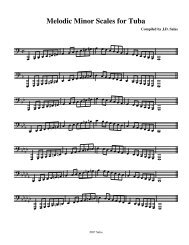
![Finale 2008 - [Chromatic Scales - Tuba.MUS]](https://img.yumpu.com/36500491/1/190x245/finale-2008-chromatic-scales-tubamus.jpg?quality=85)
